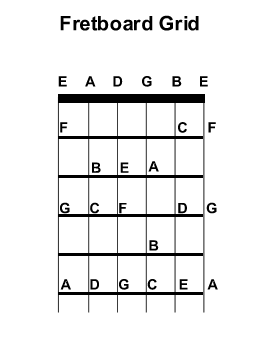Using the chord formulas below, you can easily work out all your basic open chords (chords that use open strings). For example if you wanted to know the open chord for a C Major chord you would see that the formula for a Major chord is to combine the 1st 3rd and 5th notes from the C Major scale. Looking at the common major scales listed below, the three notes would be C E and G Now that you know what notes are in your chord, use the neck grid to work out ways of playing these notes on the fretboard. You don't have to play all 6 strings, however it is easier to strum open chords if you do find chord shapes that allow you to strum 5 or 6 strings at once. If the chord only has 3 notes as in our example, just duplicate some of the notes on the other strings. Try to find chord shapes that fit easily under your fingers and that you think sound good. It doesn't matter if you have 2 x C notes 3 x E notes and 1 x G note, it is still a C major chord. As long as you have at least one of each note from the formula in your chord shape it will be correct, however if you include any notes apart from those in the formula, it would be a different chord. These can sound great too! So please experiment, it will help you understand what chords are and how they relate to their parent major scales. This one page is all you need to work out most of the open chords you will ever need for easy chord progressions and songs that don't require bar chords. If you are creating minor chords you still use the notes from the Major scales. For example if you are looking for an A minor chord shape, first find out the correct chord formula for a minor chord, which is 1 b3 and 5. To make a note flat (b) just move one fret lower on the fretboard. Lower is of course related to pitch so it is toward the tuning machines. To make a note sharp (#) just move one fret higher on the fretboard, which would be towards the bridge. So once you know the notes for the chord, in this A minor chord example we look at the A Major scale and find that we need the notes A C and E. Because the formula says we need a b3rd this lowers the note C# down to a natural C note. Still using this example we find we can use the open E on the first string (thinnest one), the C at the first fret on the second string, the A on the second fret on the third string, another E on the second fret on the fourth string, another A on the open fifth string and another E on the open sixth string. Try and work out these chords to get the hang of it. Em (E minor), A (A major), D7 (D Dominant 7) Note: Chords will sound best if you have the root note as the lowest (bass) note of the chord. So for say D chords you may only need to find the notes on the first four strings and leave the open D on the fourth string as your tonic or root note and not strum the fifth and sixth strings. |
|||||||||||||||||||||||||||||||||||||||||||||||||||||||||||||||||||||||||||||||||
|
|||||||||||||||||||||||||||||||||||||||||||||||||||||||||||||||||||||||||||||||||
|
|||||||||||||||||||||||||||||||||||||||||||||||||||||||||||||||||||||||||||||||||

|
|||||||||||||||||||||||||||||||||||||||||||||||||||||||||||||||||||||||||||||||||